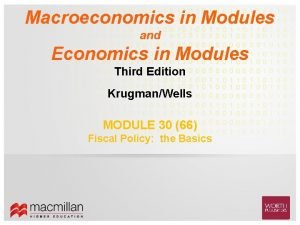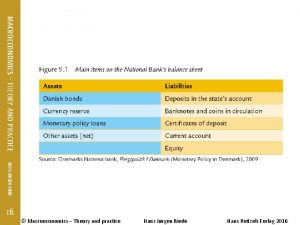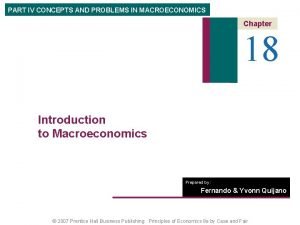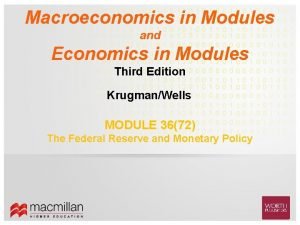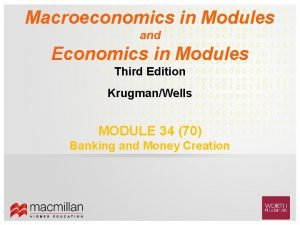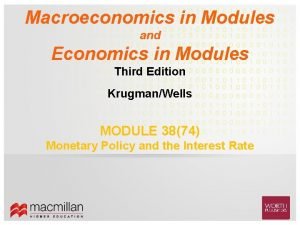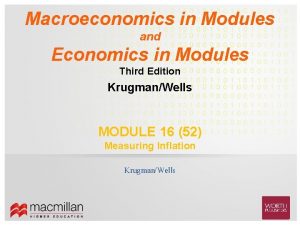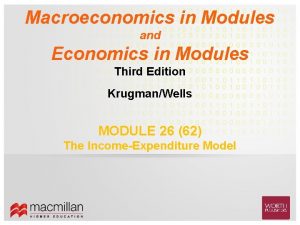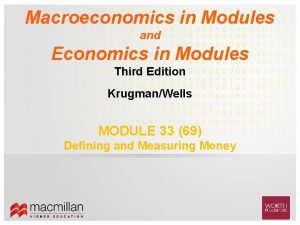Macroeconomics in Modules and Economics in Modules Third















- Slides: 15

Macroeconomics in Modules and Economics in Modules Third Edition Krugman/Wells MODULE 14 (50) Categories of Unemployment

What You Will Learn 1 The three different types of unemployment and their causes 2 The factors that determine the natural rate of unemployment 2 of 14

The Natural Rate of Unemployment • Workers who spend time looking for employment are engaged in job search. • Frictional unemployment is unemployment due to the time workers spend in job search. 3 of 14

The Nature of Unemployment Labor Market Flows in an Average Month in 2007 4 of 14

The Nature of Unemployment Distribution of the Unemployed by Duration of Unemployment, 2007 5

The Nature of Unemployment • Structural unemployment is unemployment that results when there are more people seeking jobs in a labor market than there are jobs available at the current wage. 6

Structural Unemployment The Effect of a Minimum Wage on the Labor Market Wage Rate Structural unemployment W F Minimum wage W E QD QE QS Quantity of Labor 7 of 14

Structural Unemployment • Minimum wages - a government-mandated floor on the price of labor. In the U. S. , the national minimum wage in 2009 was $7. 25 an hour. • Unions - by bargaining for all a firm’s workers collectively (collective bargaining), unions can often win higher wages from employers than the market would have otherwise provided when workers bargained individually. 8 of 14

Structural Unemployment • Efficiency wages - wages that employers set above the equilibrium wage rate as an incentive for better performance. • Side effects of government policies - public policies designed to help workers who lose their jobs; these policies can lead to structural unemployment as an unintended side effect. • Mismatches between employees and employers – caused by the time it takes for workers and firms to adjust to shifts in the economy; includes skills mismatch and geographic mismatch. 9 of 14

The Natural Rate of Unemployment • The natural rate of unemployment is the normal unemployment rate around which the actual unemployment rate fluctuates. • The natural rate of unemployment is the unemployment rate that arises from the effects of frictional plus structural unemployment. • Cyclical unemployment is a deviation in the actual rate of unemployment from the natural rate. 10 of 14

The Natural Rate of Unemployment • Natural unemployment = Frictional unemployment + Structural unemployment • Actual unemployment = Natural unemployment + Cyclical unemployment 11 of 14

Changes in the Natural Rate of Unemployment • Estimates of the natural rate of unemployment show that the U. S. natural rate rises and falls over time. • The factors that affect the natural rate of unemployment include: – Changes in labor force characteristics – Changes in labor market institutions – Changes in government policy 12 of 14

Changes in the Natural Rate of Unemployment The Changing Makeup of the U. S. Labor Force, 1948 -2013 13 of 14

Economics in Action Natural Unemployment Around the OECD 14 of 14

Summary 1. Job creation and destruction lead to job search and frictional unemployment. 2. A variety of factors such as minimum wages, unions, efficiency wages, and government policies designed to help laid-off workers result in a situation in which there is a surplus of labor at the market wage rate, creating structural unemployment. 3. The natural rate of unemployment, the sum of frictional and structural employment, is well above zero, even when jobs are plentiful. 4. Cyclical unemployment is the deviation of the actual rate of unemployment from the natural rate. 5. The natural rate of unemployment changes over time. 15 of 14
 Macroeconomics in modules
Macroeconomics in modules Macroeconomics definition economics
Macroeconomics definition economics Economics modules
Economics modules Gj mount classification
Gj mount classification Blacks classification
Blacks classification Economics and business economics maastricht
Economics and business economics maastricht Principles of economics third edition oxford pdf
Principles of economics third edition oxford pdf What is mathematical economics
What is mathematical economics Macro vs micro definition
Macro vs micro definition Micro macro economics
Micro macro economics New classical macroeconomics
New classical macroeconomics Ap macroeconomics supply and demand analysis
Ap macroeconomics supply and demand analysis Macroeconomics theory and practice
Macroeconomics theory and practice New classical and new keynesian macroeconomics
New classical and new keynesian macroeconomics Branches of economics
Branches of economics Components of macroeconomics
Components of macroeconomics
